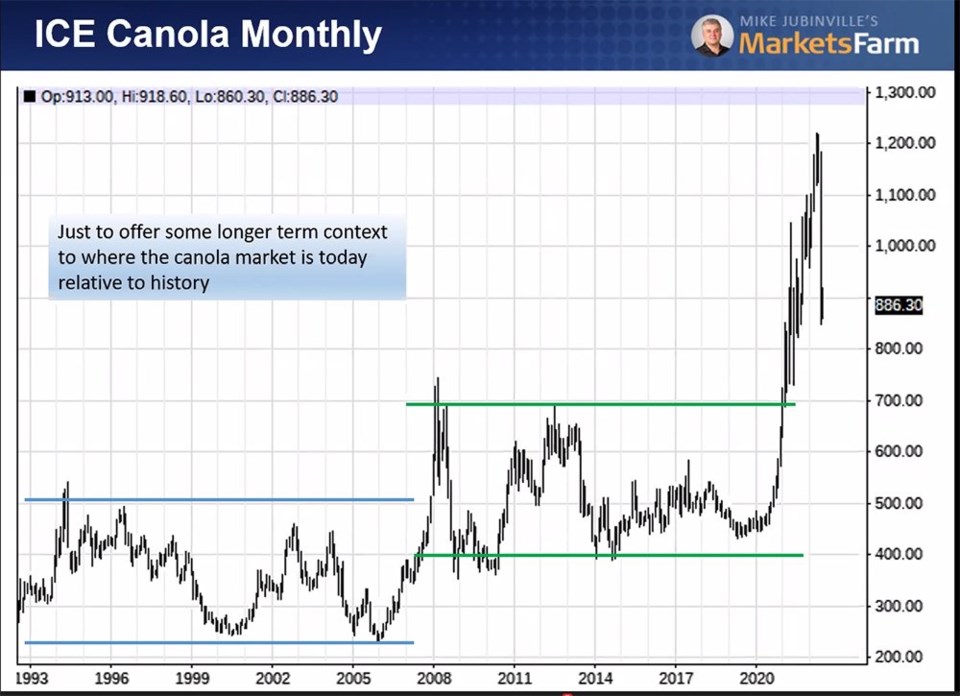WESTERN PRODUCER — The canola market is in the process of shifting to a new trading range, says MarketsFarm analyst Mike Jubinville.
From the early 1990s to the early 2000s canola futures traded in the range of $250 to $500 per tonne.
In the post-biofuel era it shifted higher to the $400 to $700 range.
Jubinville believes the market is attempting to establish a new, higher range in the renewable diesel era.
“What’s the new trading range? Honestly, I don’t know,” he said.
In the short-term he thinks the floor will be around $800 per tonne and that a rebound to $900 should be easily attainable in the coming days and weeks.
That would be a potential selling point for farmers, but he would be inclined to sit tight.
Jubinville is forecasting 19 million tonnes of canola production, which will be gobbled up by an anticipated 10.5 million tonnes of crush and 8.5 million tonnes of exports in 2022-23.
Ending stocks will remain tight at about 1.2 million tonnes.
He believes the market is in “oversold territory” after the June price crash.
However, canola will need to be priced competitive with soybeans in 2022-23 after a year when it was way out of whack with its sister commodity.
MarketsFarm analyst Bruce Burnett thinks the wheat price plunge is over.
“I don’t think there’s a need for the market to go down any further from here,” he said.
World wheat production is expected to fall this year and will be 13 million tonnes below consumption levels, so stocks will shrink.
The United States is harvesting the smallest winter wheat crop since 1963. Combined stocks of hard red winter wheat and spring wheat in the U.S. will be the lowest since 2008.
The U.S. Department of Agriculture is forecasting spring wheat yields of 51 bushels per acre in North Dakota, but MarketsFarm thinks it will be closer to 48 or 49.
MarketsFarm is forecasting 25.3 million tonnes of Canadian wheat production, a vast improvement over last year. However, ending stocks will be nearly identical at 3.6 million tonnes due to low beginning stocks and strong demand.
Durum production in France, Italy and Spain will be reduced from last year’s levels due to drought. The French crop will be down nearly 16 percent, according to the latest estimates.
North Africa harvested 4.15 million tonnes of durum, the smallest crop since 2016.
“The entire production in the Mediterranean Basin has been poor,” said Burnett.
The USDA is forecasting 2.1 million tonnes of U.S. durum, but MarketsFarm believes it will be closer to 1.7 million tonnes.
Some analysts are forecasting six million tonnes of Canadian production, but Burnett thinks five million tonnes might be optimistic.
Durum prices have tumbled to $12 to $13 per tonne from more than $20 in early February despite all the reports of poor crops. Prices are being dragged down by macroeconomic factors and falling spring wheat values.
“As we see demand arrive to the market, I think we’re probably going to see prices perk up a little bit,” he said.
Jubinville said cash prices for feed barley in Lethbridge are pulling back as Canadian farmers prepare to harvest a 10 million tonne crop, up from seven million tonnes last year.
The price is around $400 per tonne, down $60 from the peak in June.
New crop barley bids of $8.50 per bu. in southern Alberta and $7 to $7.50 in Saskatchewan are attractive, considering the Vancouver export price backed off to Saskatchewan amounts to around $7.
Prices won’t be able to run up too far above the landed price of U.S. corn in southern Alberta because Western Canada will still likely need to import 2.5 million tonnes of U.S. corn in 2022-23.
That is half of this year’s record-smashing imports but still way above normal levels.
Jubinville believes the oat market has topped out, barring a crop disaster. He is forecasting 4.4 million tonnes of Canadian production, up from 2.7 million tonnes last year.
Users of the crop will be desperate to reload supplies straight off the combine.
“Essentially the oat processors in North America are running on fumes at the moment,” he said.
A grower from southern Manitoba recently asked him if $6.25 off the combine is a good price. Jubinville said he would sell some production at that price if the grower is confident in his yields.
Old crop yellow pea prices are trending down as they converge with new crop prices of $13 to $14 per bu.
He said the days of extraordinary prices in the $17 to $18 range are over because growers will need to expand sales beyond the North American pet food and fractionation market in 2022-23 due to larger supplies of the crop.
For instance, they will likely be shipping 1.5 million tonnes of peas to China. The total export program will be around 2.5 million tonnes.
New crop green lentil prices are remaining elevated in the 44 to 45 cents per pound range due to snug beginning supplies.
Red lentil price rallies usually last about two years and then trend down. He believes that is what is happening in that market right now with prices at 30 cents, down from the peak of nearly 50 cents.




